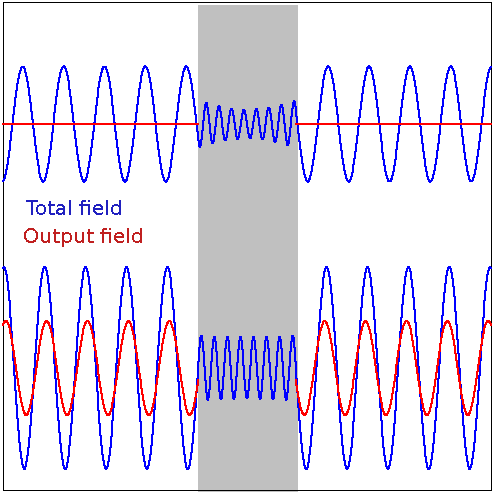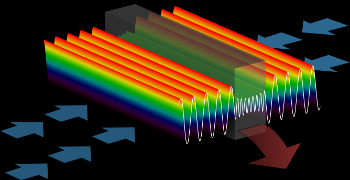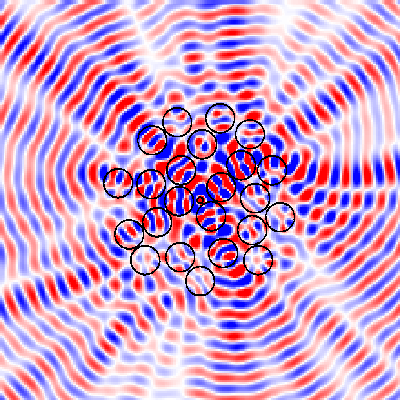Coherent Perfect Absorbers: Time-reversed Lasers [PRL 105, 053901 (2010)] [Science 331, 6019 (2011)].
Recently, our group has been investigating the concept of a "time-reversed laser".
A laser is an optical system that supports purely-outgoing radiation patterns. Above the lasing threshold, it is inherently non-linear (click here for our research on nonlinearity in random lasers). However, a laser at threshold can be described using a simple linear wave equation, with an amplifying refractive index (i.e. complex, with a negative imaginary part).
We refer to the time-reversed counterpart of a laser as a coherent perfect absorber (CPA). This is an optical system that supports a purely incoming radiation pattern—the time-reverse of the lasing mode—with complete absorption and zero reflection (see Fig. 1 and Fig. 2).

Fig. 1: Illustration of the "coherent perfect absorber" (CPA) principle. Two equal-intensity light beams are directed onto opposite sides of a slab containing a slightly absorbing medium (gray box). The total electric field is shown in blue, and its outgoing component in red. If we correctly choose the relative phase of the input beams (upper plot), the slab absorbs the light completely. With a different relative phase, the slab instead becomes strongly scattering, and most of the input light re-emerges without being absorbed.
 |
 |
Fig. 2: A more precise numerical (FDTD) simulation, using light of wavelength 737 nm incident on a 10-micron silicon slab. Here, the red and blue regions show where the electric field is positive and negative, respectively. Again, the frequency and relative phase of the light is chosen to correspond to a "coherent perfect absorber" mode.
Coherent perfect absorption arises from the interplay of interference and absorption. In the presence of specific amounts of dissipation, there exist interference patterns that trap the incident radiation for an infinite time. However, just like laser radiation, coherent perfect absorption only occurs within narrow frequency bands.
A CPA must satisfy certain conditions: for a given frequency and geometry, it must contain a specific degree of material dissipation—exactly as much dissipation as a corresponding laser has amplification. However, we have shown that it is not terribly difficult to satisfy these conditions. One approach is to make use of an indirect bandgap semiconductor, where the dissipation varies smoothly as a function of frequency, and we can simply scan for a frequency where the dissipation is just what we need. Furthermore, the dissipation does not need to be very high; even small rates of single-pass absorption can lead to perfect absorption. The CPA is a novel interferometric optical element which allows controlled delivery of energy to the device by modulating the phases of the input signals.
Our original theoretical paper on the subject was published in Physical Review Letters. See also the Physics Viewpoint article by Stefano Longhi.
Recently, we have worked with the Cao group on an experimental demonstration of the "two-port" CPA effect, using a simple silicon wafer as the absorber. The results have been published in Science.

This is the reverse of what happens in a laser. There, energy is delivered into a "gain medium", and emerges as coherent light.

Fig. 4: The time-reversal analogy between lasing and coherent perfect absorption can be carried into more complicated cavities as well, to produce unusual optical absorbers. In this example, a small region near the center of the system, with dimensions much smaller than the wavelength of light, contains a strongly-absorbing material. It is surrounded by scatterering discs composed of non-absorbing dielectric material. An appropriately chosen incident waveform penetrates the scattering region, and is perfectly absorbed into the sub-wavelength region.

